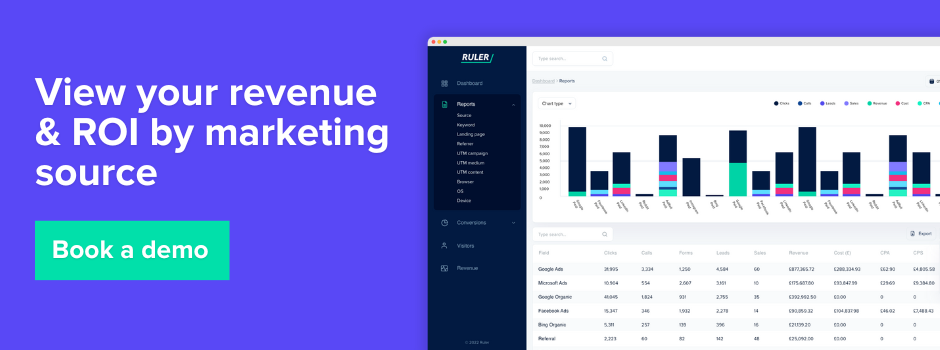Want to learn how to measure your marketing performance effectively? We break down all of the key metrics you need to be tracking in your reports and how to get more data more easily.
Marketing teams face a lot of pressure when it comes to job performance. Not only do they need to drive revenue, but also prove it.
Without the right metrics, you’re going to struggle to prove your direct (and indirect) impact on new leads and sales.
Measuring your marketing performance effectively can ultimately allow you to monitor success and attribute revenue back to your marketing campaigns.
Related: How to measure marketing with Ruler Analytics
We found that just 23% of marketers are confident they’re tracking the right KPIs so it’s clearly an issue many marketers are facing.
Everything you do in business needs to have a measurable ROI. This is particularly true for marketing. As marketing has evolved, so have the means to track it. And while creativity in marketing is essential, you need to have processes and data behind it.
Hear us out.
You can’t create a piece of content, push it out and just leave it, right? Tracking and reporting, both online and offline conversions, is essential to understanding whether your efforts are having any impact.
Generating leads, through phone calls, form submissions and live chat, is one thing, but how exactly do you track those leads through the full customer journey? Well, that’s exactly what we’re here to share.
Keep reading to learn:
💡 Pro Tip
To measure marketing performance, ruler tracks the user’s journey from initial touchpoint to conversion. It uses click path data to understand how different touchpoints contribute to leads and revenue. When unique identifiers are missing, machine learning models are employed to estimate impressions and link them to revenue, allowing for reattribution and measurement of TOFU activities’ impact.
Book a demo and elevate your measurement game
When you think of a marketing report, what do you think of?
Probably metrics like:
While these are good metrics to track, what do they actually measure?
In reality, metrics like these only highlight the potential of your marketing as opposed to actual results on your bottom line.
Related: Vanity metrics vs actionable metrics
To get a marketing report that your senior management is going to take notice of, you need to go deeper.
But you might be thinking to yourself, well, what’s stopping me?
There are some key issues at play when it comes to effectively measuring your marketing performance and why many marketers rely on vanity metrics that just scratch the surface.
It can be really hard to link anonymous website visitors to closed sales. That’s the long and short of it. Keep reading to find out how you can get the metrics you need.
Think about how many marketing channels you regularly use. And think about the sheer number of content pieces you release within a month.
All of these pieces of content are potential marketing touchpoints that a prospective customer could engage with.
How do you measure how each of these channels, campaigns and content pieces work together to generate new leads, close sales and drive customer loyalty?
To effectively measure your marketing performance you need to track:
The first way to measure your marketing performance is to look at the amount of revenue it’s generated.
The issue you might have here is linking your sales back to your marketing. But don’t worry, you’re not alone. And it isn’t difficult to solve.
Related: How to link revenue to your Google Analytics
Revenue attribution is an easy solution and simple to get started. With tools like ours, as leads come in, Ruler will track them and their original marketing source. As they continue engaging with you, Ruler Analytics will compile their full customer journey.
At the point of conversion, all the data held on them is fired over to your CRM so you have the right lead data to hand. And, when they convert into a sale, Ruler will scrape the revenue data from your CRM and fire it to your chosen marketing apps. There it will be automatically attributed to the influencing marketing channels, campaigns, ads and even keywords.
Chances are you drive leads through your marketing via conversion points like phone calls, form submissions or maybe even live chat.
Tracking each of these entry points is key to understanding what volume of leads you’re driving through marketing.
But there’s an issue here. Chances are, you’re just counting the number of leads you’ve generated.
While lead volume is important, you also need to be able to prove which channels impact pipeline activity. And, you’ll need to be able to see how many of those leads go on to become sales.
Tracking each stage of the customer journey will help you better understand how your marketing channels and collateral are working together to drive new leads.
And remember, always try to go beyond lead volume and track lead value instead.
Understanding your customer retention is mostly applicable to companies using a subscription service or who want to promote repeat business.
And when it comes to customer loyalty, there are a few factors in play.
Loyalty could be customers acting as advocates, repeat business, or it could be just engaging with your content.
By understanding how customers are currently interacting, you can better identify what customer loyalty looks like for your business.
Related: How to reduce your cost per acquisition cost
Lead nurture is either managed by your sales team or passed to marketing automation.
Once a lead is generated, it’ll be pinged over to your CRM where your marketing team will have little involvement with it.
From there, your sales team will contact the lead and try to progress them through a pipeline.
If your business is fully optimised to drive revenue, however, then you should be working towards achieving sales and marketing alignment.
Ideally, your sales and marketing teams will be looking at the sales cycle holistically as opposed to breaking it into two halves.
Managing your leads allows you to understand where in the pipeline they currently are and what steps need to be taken to drive them further down the funnel.
Related: Best lead management and tracking software
Brand awareness metrics contextualise your brand’s reach and prove how marketing is helping expand that awareness. Common individual metrics that point to changes in brand awareness include direct traffic or organic traffic for branded terms.
Generally speaking, direct traffic can help you get a good idea of your brand awareness.
Related: What is direct traffic in Google Analytics
Some marketers also track social media follower counts, the number of inbound links, and the number of online brand mentions. These are a good indication of how many people are aware of your brand.
Engagement metrics span across email, social, web content and more. They simply measure how engaged your current and potential customers are with your marketing campaigns and content.
Common engagement metrics include:
Generally speaking, engagement metrics only highlight the potential of your marketing.
Related: A complete guide to measuring your marketing
Some of those metrics we’ve listed might seem obvious.
But going beyond numbers and providing context is key.
While you might think measuring revenue is saying you closed £5,000 in the last month, it’s actually linking those individual sales to marketing channels, campaigns and more.
Sound hard?
We’ll show you how we do it here in our own marketing team.
To track the most important metrics for marketers, we use visitor-level analytics that allows us to track customer interactions across the entire customer journey.
Or, in short, our very own marketing attribution tool, Ruler Analytics.
It allows our marketing team to get to the detail of what’s working to drive inbound revenue.
We simply connect our CRM to our marketing data. If a lead comes in via email, but then converts via a phone call, well, we can track that.
If a lead comes in via paid advertising but then converts via a separate web session where they complete a form, we can track that too. And even better, we’ll fire it right back to your reporting software of choice.
To see the true value of your marketing, you need a view of not only how prospects and customers are interacting with marketing campaigns and assets, but also how they interact with sales teams down the line.
In the past, this has been difficult at best, downright impossible at worst.
Why? Because sales and marketing teams typically work in separate systems.
Marketing tends to track things like traffic, links, form completions, and time-on-site. But sales tend to track the metrics like conversions, revenue, and return/repeat purchases.
While metrics like traffic and links are important, they only go so far to tell you what’s working well.
To get a full view of marketing performance, you need a tool that synthesizes all of that data to provide a complete picture, and Google Analytics just doesn’t cut it.
And as the solution didn’t exist, we built one.
Here’s how we measure marketing performance:
We use our platform to monitor all of our marketing initiatives, allowing us to track traditional metrics like traffic, referrals, and form completions.
Ruler Analytics also tracks this data at a visitor level, both known and anonymous, allowing us to isolate activity down to specific prospects.
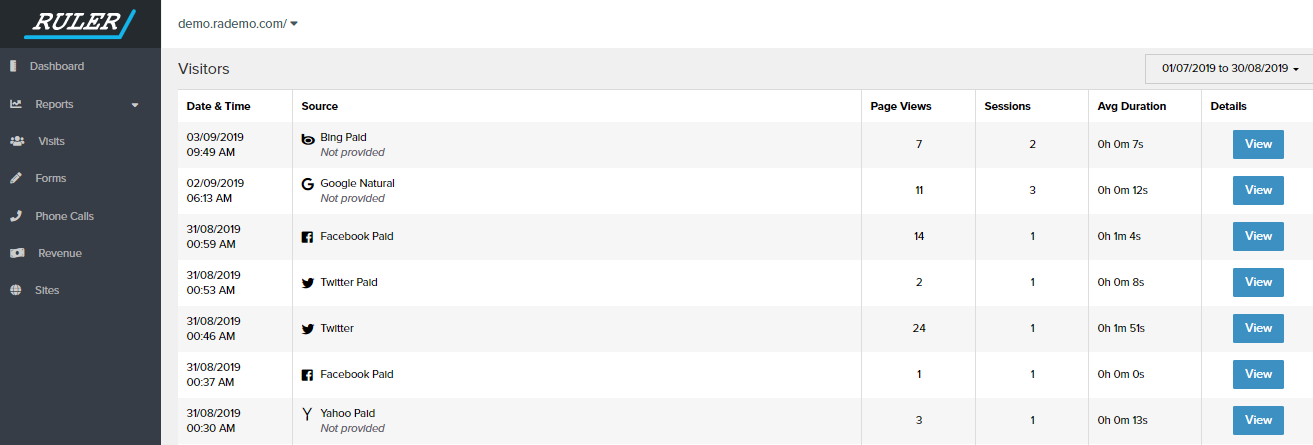
Whenever a visitor converts via phone call or form fill, we send that conversion data to our CRM. We have integrations that can achieve this, but with Zapier, you can send any marketing data from Ruler Analytics to over 1,000 tools. This populates the sales team’s system with all marketing data, which helps our salespeople learn more about prospects’ interests before reaching out to them.
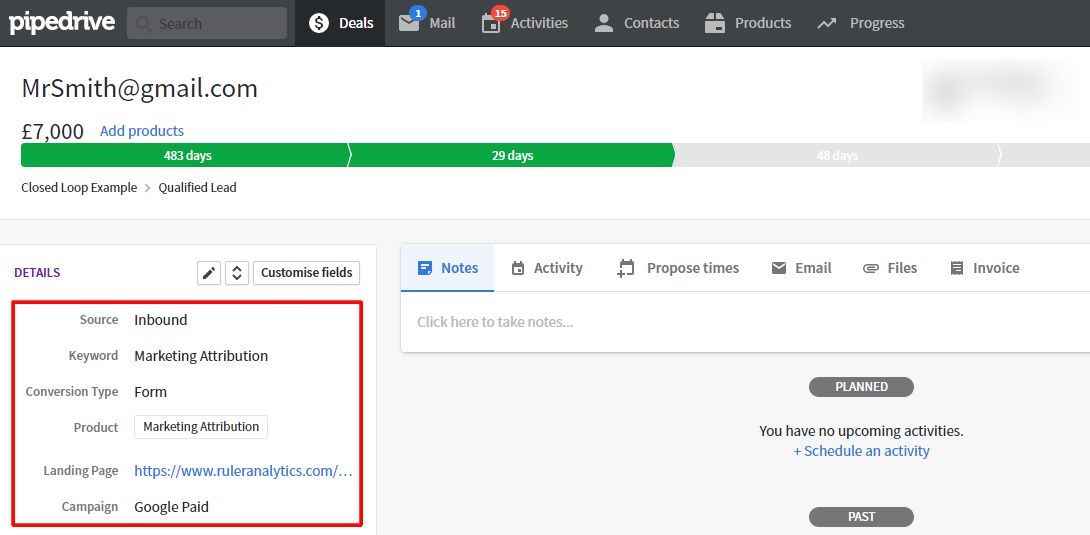
When sales teams convert marketing-generated leads and enter the sales amounts into our CRM, it feeds that data back to the Ruler Analytics dashboard.
This gives us a complete view of how many conversions we’re generating and exactly how much revenue those conversions brought in. You can see exactly how much revenue different channels and campaigns generate.
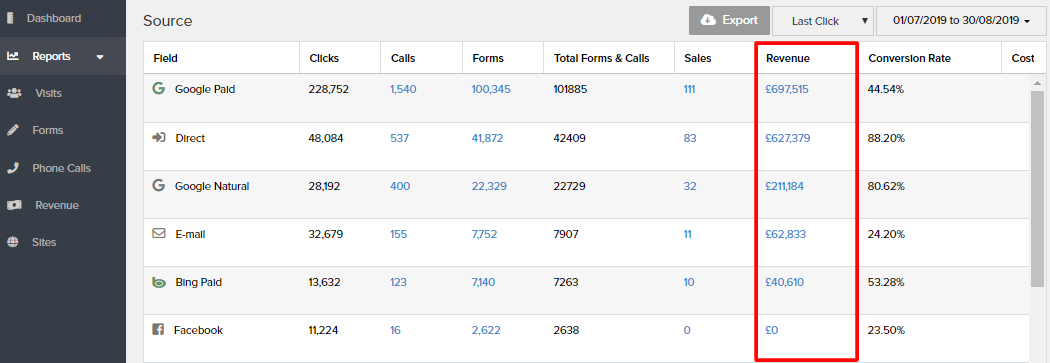
The great thing about reports like this is that it makes it easy to optimise.
Let’s say, at the end of the month, you populate a report showing how much revenue you generated and which marketing touchpoints prospects interacted with before converting.
You may see that 90% of your revenue comes from customers who discovered you through organic search by landing on the content you’ve published on your blog.
On the other hand, while you get a lot more traffic from social media than organic search, only 10% of your revenue comes from your social media marketing initiatives.
Because you can now see revenue, you know that your social media campaigns are underperforming.
However, if you could only see traffic referrals, it would look like your social media campaigns were performing much better than your content marketing initiatives.
But now you know that’s not the case.
You decide to double down on content marketing and slow down your social media marketing, and the next month, marketing-generated revenue doubles.
As previously mentioned, Ruler Analytics supports integrations with more than 1,000 tools and apps.
Meaning, you can connect data from your Ruler Analytics account into your Google Analytics, CRM, and social media monitoring platforms and view all of that data within those applications.
For example, as you can see below, any sales that have been attributed to a Ruler Analytics dynamic number have been sent into Google Analytics.
So, not only can the marketing team see how many phone calls a source has generated, but how much revenue it’s produced for the business.
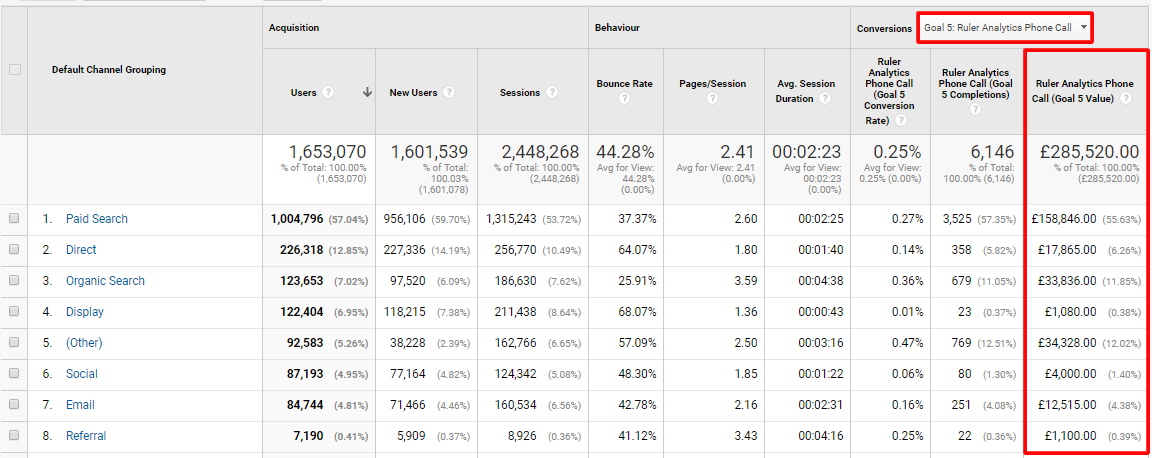
Essentially, you can close the loop between online marketing and offline sales: connect real values—actual revenue amounts—back to the marketing campaigns, sources or keywords that generated them.
And there you have it. A quick guide on the ways you can measure your marketing efforts, plus, how we do it here at Ruler.
Remember, the key to best understanding how your marketing is working to drive your bottom line is to connect your marketing to your revenue.
Not sure how to get that in place? Read our guide to closed-loop marketing attribution. It sounds complicated, but it’s an easy way to connect your sales back to your marketing channels and campaigns.
Or, if you want to see the data in action, then book a demo with our team.
